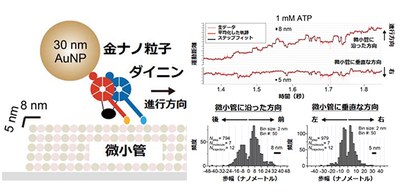
Small stepping motion of linear motor dynein resembles drunken stagger
A group of researchers from the Institute for Molecular Science, The University of Tokyo and Osaka University has revealed a small stepping motion of processive dynein by load-free high-speed single-particle tracking.
Linear motor proteins, such as dynein and kinesin, move along microtubules to transport cargo, such as organelles and vesicles, from the center of a cell to its periphery using energy from adenosine triphosphate (ATP).
Using a gold nanoparticle (AuNP) with a nominal diameter of 30 nm as a probe for dark-field microscopy imaging (because AuNP strongly scatters light), with their unique total internal reflection dark-field laser microscopy, this group visualized load-free fast stepping motion of artificially dimerized chimeric dynein (the structure of dynein microtubule binding domains had been well-studied by cryo-electron microscopy) with high time resolution and localization precision.
In dark-field microscopy, a sample contrast comes from light scattered by the sample, but in total internal reflection dark-field microscopy, high-contrast images of coherently scattering samples are delivered by introducing a laser beam as an illumination light source.
The researchers visualized the small stepping motion of dynein by load-free high-speed single-particle tracking at a physiologically relevant high ATP concentration, in which load-free fast motion of dynein is allowed, with 100 μs time resolution and sub-nanometer localization precision. Unlike kinesins, which move along the microtubules toward the plus ends, dyneins showed forward, backward, and side steps, similar to the stagger of a drunk person.
This group also clarified that the step size of dynein is smaller than that of previous studies using low-speed single-particle tracking with conventional microscopy and that the step sizes matched well with the minimum pitches of the binding cleft of αβ-tubulin dimer on the microtubule. High-speed single-molecule imaging with high time resolution allowed for clear visualization of the small stepping motion.
Unlike kinesins, which move in a highly coordinated hand-over-hand manner without backward and side steps, the stepping motion of each motor domain (head) of dyneins was found to be uncoordinated.
This group’s achievements clarified diversity in stepping motions of linear molecular motors, providing important guidelines for creating linear motors with artificial molecules. The researchers also showed that intracellular cargo transport could be achieved with uncoordinated small stepping motion. These findings eased restrictions on designing nanosized linear motors with artificial molecules, enhancing the possibility of such motors.

Figure 1

Figure 2
The article, “Small stepping motion of processive dynein revealed by load-free high-speed single-particle tracking,” was published in Gastroenterology at DOI: https://doi.org/10.1038/s41598-020-58070-y.
